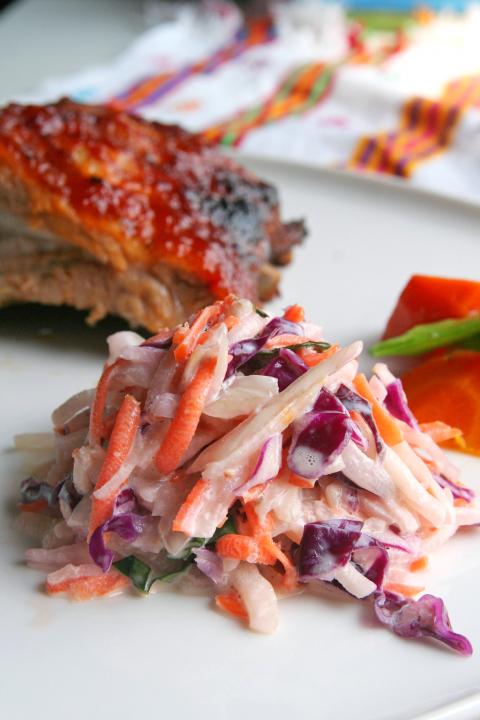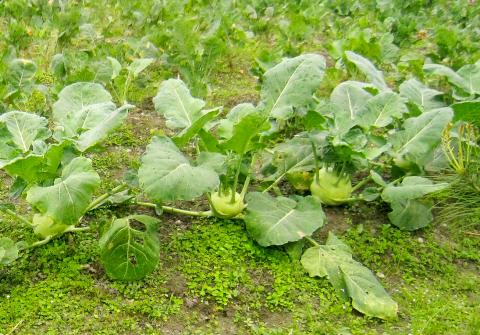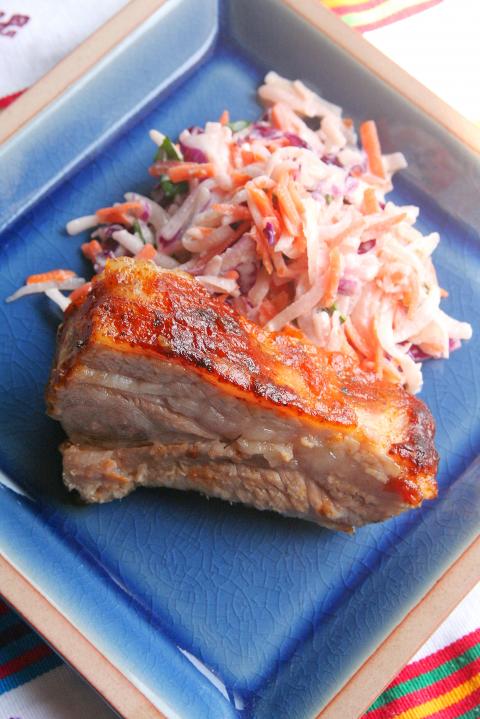Kohlrabi is a vegetable with image issues. Quite apart from its peculiar name, about which more later, it looks like an alien from a low budget science fiction movie. Moreover, this hard globe, protected by a tough outer skin, does not offer the prospective cook any easy clues about how to proceed. Kohlrabi was once widely cultivated in Europe, and is still popular in Germany and some parts of Eastern Europe, but has become sidelined as something of an oddity in the culinary mainstream.
In Taiwan, kohlrabi is most commonly referred to as “big head vegetable” (大頭菜), and has a long history, used particularly in soup or as a pickle. Probably the best-known kohlrabi dish for Taiwanese is kohlrabi and short rib soup (大頭菜排骨湯), which uses the stem very much as you might use a daikon radish, and while perfectly tasty, does not even begin to show the versatility of this much neglected vegetable.
The name kohlrabi is derived from the German kohl meaning cabbage and rube (or rabi) meaning turnip. It belongs to the Brassica family, which includes cabbage, broccoli, cauliflower, and brussels sprouts. Despite its name, it is no relation to the turnip. It is sometimes mistaken for a root vegetable, but in fact the large bulb of the kohlrabi grows above ground. Its flavor is delicate, with hints of broccoli stem and radish, and depending on how you cook it, the texture can vary from crunchy to spongy.

Photo: Ian Bartholomew
There are theories that kohlrabi has been relegated to its current marginal position by its “more flavorful” relatives such as broccoli and cabbage. My own experience is that kohlrabi is both quite distinctive and can stand up to any of these more recognized relatives. The reason for this may well be its marginal status. As it is not a major economic crop, it is generally grown in a slower, more sustainable fashion. Flavor-wise, I have found it to be much more satisfying than supermarket-purchased broccoli, which often seems profoundly devoid of taste and is only consumed because we are repeatedly told how healthy it is.
Once you get beyond kohlrabi’s intimidating appearance, it is actually remarkably easy to process. The dense bulb should be quartered, and the thick outer skin cut away, leaving a tender flesh that can be diced, sliced or grated and cooked in a wide variety of ways. (It should be mentioned that the leaves of the kohlrabi can also be eaten, and are said to resemble the flavor of cabbage, but generally “big head vegetable” is sold without foliage.)
Kohlrabi is a very healthy vegetable that packs lots of nutrition into a very low calorie package. It is a rich source of Vitamin C, with higher levels even than oranges, and has good levels of minerals: copper, calcium, potassium, manganese, iron, and phosphorus. It has health-promoting phytochemicals that appear to have anti-cancer and anti-inflammatory effects. They are good for keeping chronic, low-level inflammations in check, which in turn helps reduce the risk of heart disease, stroke, diabetes, Alzheimer’s and osteoporosis.

Photo: Ian Bartholomew
Kohlrabi can be eaten raw, finely sliced or grated. Eating it this way highlights its crunchy texture, and its porous flesh means that it takes up flavors well. It therefore works particularly well with slaws (see recipe) and salads. Its own subtle flavor is best highlighted by roasting: just pop diced kohlrabi in the oven with some olive oil, salt, pepper and thyme at 200 degrees Celsius for about 45 minutes. Shredded, it works well as fritters, or steamed, it can be turned into a lovely puree.
Recipe: Kohlrabi Slaw (serves four)
Ingredients

Photo: Ian Bartholomew
1 medium sized kohlrabi
150g carrot, grated
100g red cabbage, roughly chopped
50g brown onion, finely sliced
1/2 tbsp cider vinegar
1 tbsp sugar
Generous pinch each of salt and pepper
Basil leaves, chopped
1/2 cup homemade mayonnaise
(In this age of the electrical whisk and food processor, there is really no excuse for not making your own mayonnaise. Sore arms and split emulations are a thing of the past and minimal care is now required to produce a luscious mayo without a host of stabilizers and preservatives.)
Directions
1. Quarter the kohlrabi bulb and cut away the thick outer skin. Roughly grate and set aside.
2. Lightly salt the onion and cabbage in separate bowls. Allow to stand for about 20 minutes until they begin to express liquid. Squeeze dry.
3. Place all the ingredients together in a bowl and mix well. Adjust seasonings. Chill for two hours and serve.
Ian Bartholomew runs Ian’s Table, a small guesthouse in Hualien. He has lived in Taiwan for many years writing about the food scene and has decided that until you look at farming, you know nothing about the food you eat. He can be contacted at Hualien202@gmail.com.

May 18 to May 24 Pastor Yang Hsu’s (楊煦) congregation was shocked upon seeing the land he chose to build his orphanage. It was surrounded by mountains on three sides, and the only way to access it was to cross a river by foot. The soil was poor due to runoff, and large rocks strewn across the plot prevented much from growing. In addition, there was no running water or electricity. But it was all Yang could afford. He and his Indigenous Atayal wife Lin Feng-ying (林鳳英) had already been caring for 24 orphans in their home, and they were in

On May 2, Chinese Nationalist Party (KMT) Chairman Eric Chu (朱立倫), at a meeting in support of Taipei city councilors at party headquarters, compared President William Lai (賴清德) to Hitler. Chu claimed that unlike any other democracy worldwide in history, no other leader was rooting out opposing parties like Lai and the Democratic Progressive Party (DPP). That his statements are wildly inaccurate was not the point. It was a rallying cry, not a history lesson. This was intentional to provoke the international diplomatic community into a response, which was promptly provided. Both the German and Israeli offices issued statements on Facebook

President William Lai (賴清德) yesterday delivered an address marking the first anniversary of his presidency. In the speech, Lai affirmed Taiwan’s global role in technology, trade and security. He announced economic and national security initiatives, and emphasized democratic values and cross-party cooperation. The following is the full text of his speech: Yesterday, outside of Beida Elementary School in New Taipei City’s Sanxia District (三峽), there was a major traffic accident that, sadly, claimed several lives and resulted in multiple injuries. The Executive Yuan immediately formed a task force, and last night I personally visited the victims in hospital. Central government agencies and the

Australia’s ABC last week published a piece on the recall campaign. The article emphasized the divisions in Taiwanese society and blamed the recall for worsening them. It quotes a supporter of the Taiwan People’s Party (TPP) as saying “I’m 43 years old, born and raised here, and I’ve never seen the country this divided in my entire life.” Apparently, as an adult, she slept through the post-election violence in 2000 and 2004 by the Chinese Nationalist Party (KMT), the veiled coup threats by the military when Chen Shui-bian (陳水扁) became president, the 2006 Red Shirt protests against him ginned up by